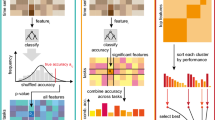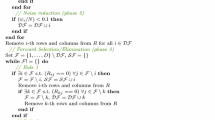Abstract
Many systems in our world age, degrade or otherwise move slowly but steadily in a certain direction. When monitoring such systems by means of sensors, one often assumes that some form of ‘age’ is latently present in the data, but perhaps the available sensors do not readily provide this useful information. The task that we study in this paper is to extract potential proxies for this ‘age’ from the available multi-variate time series without having clear data on what ‘age’ actually is. We argue that when we find a sensor, or more likely some discovered function of the available sensors, that is sufficiently monotonic, that function can act as the proxy we are searching for. Using a carefully defined grammar and optimising the resulting equations in terms of monotonicity, defined as the absolute Spearman’s Rank Correlation between time and the candidate formula, the proposed approach generates a set of candidate features which are then fitted and assessed on monotonicity. The proposed system is evaluated against an artificially generated dataset and two real-world datasets. In all experiments, we show that the system is able to combine sensors with low individual monotonicity into latent features with high monotonicity. For the real-world dataset of InfraWatch, a structural health monitoring project, we show that two features with individual absolute Spearman’s \(\rho \) values of 0.13 and 0.09 can be combined into a proxy with an absolute Spearman’s \(\rho \) of 0.95. This demonstrates that our proposed method can find interpretable equations which can serve as a proxy for the ‘age’ of the system.
Access this chapter
Tax calculation will be finalised at checkout
Purchases are for personal use only
Similar content being viewed by others
References
Billard, L., Diday, E.: Symbolic regression analysis. In: Jajuga, K., Sokołowski, A., Bock, H.H. (eds.) Classification, Clustering, and Data Analysis: Recent Advances and Applications, pp. 281–288. Springer, Heidelberg (2002). https://doi.org/10.1007/978-3-642-56181-8_31
Boden, T., Andres, B.: Global CO2 Emissions from Fossil-Fuel Burning, Cement Manufacture, and Gas Flaring: 1751–2014. Carbon Dioxide Information Analysis Center, USA (2017)
Brigham, E.O.: The Fast Fourier Transform and its Applications. Prentice-Hall, Inc. (1988)
Guimerà, R., et al.: A bayesian machine scientist to aid in the solution of challenging scientific problems. Sci. Adv. 6(5), eaav6971 (2020)
Hansen, J., Ruedy, R., Sato, M., Lo, K.: Global surface temperature change. Rev. Geophys. 48, RG4004. https://doi.org/10.1029/2010RG000345(2010)
Lindauer, M., et al.: SMAC3: a versatile Bayesian optimization package for hyperparameter optimization. J. Mach. Learn. Res. 23(54), 1–9 (2022). http://jmlr.org/papers/v23/21-0888.html
Markič, Š, Stankovski, V.: Developing context-free grammars for equation discovery: an application in earthquake engineering. In: Ali, M., Bosse, T., Hindriks, K.V., Hoogendoorn, M., Jonker, C.M., Treur, J. (eds.) Contemporary Challenges and Solutions in Applied Artificial Intelligence, pp. 197–203. Springer, Heidelberg (2013). https://doi.org/10.1007/978-3-319-00651-2_27
Miao, S., Vespier, U., Vanschoren, J., Knobbe, A., Cachucho, R.: Modeling sensor dependencies between multiple sensor types. In: Proceedings of BeneLearn 2013 (2013)
Myers, J.L., Well, A.D.: Research Design and Statistical Analysis. Lawrence Erlbaum, 2nd edn. (2003)
Parkes, A.: A concise Introduction to Languages and Machines. Springer, London (2008). https://doi.org/10.1007/978-1-84800-121-3
Schmidt, M., Lipson, H.: Distilling free-form natural laws from experimental data. Science 324(5923), 81–85 (2009)
Stranneby, D., Walker, W.: Digital Signal Processing and Applications. Elsevier, Amsterdam (2004)
Todorovski, L.: Declarative bias in equation discovery (1997)
Udrescu, S.M., Tegmark, M.: AI Feynman: a physics-inspired method for symbolic regression. Sci. Adv. 6(16), eaay2631 (2020)
Vespier, U., Knobbe, A., Nijssen, S., Vanschoren, J.: MDL-based analysis of time series at multiple time-scales. In: Proceedings of ECML PKDD ’12 (2012)
Vespier, U., Knobbe, A., Vanschoren, J.: Traffic events modeling for structural health monitoring. In: Proceedings of IDA ’11 (2011)
Vespier, U., Nijssen, S., Knobbe, A.: Mining characteristic multi-scale motifs in sensor-based time series. In: Proceedings of the 22nd ACM International Conference on Conference on Information & Knowledge Management, pp. 2393–2398. CIKM ’13. ACM (2013)
Wang, Y., Wagner, N., Rondinelli, J.M.: Symbolic regression in materials science. MRS Commun. 9(3), 793–805 (2019)
West, M.: Time series decomposition. Biometrika 84(2), 489–494 (1997). https://doi.org/10.1093/biomet/84.2.489
Žegklitz, J., Pošík, P.: Benchmarking state-of-the-art symbolic regression algorithms. Genet. Program Evolvable Mach. 22, 5–33 (2021)
Author information
Authors and Affiliations
Corresponding author
Editor information
Editors and Affiliations
Rights and permissions
Copyright information
© 2025 The Author(s), under exclusive license to Springer Nature Switzerland AG
About this paper
Cite this paper
Toussaint, G., Knobbe, A. (2025). LMFD: Latent Monotonic Feature Discovery. In: Meo, R., Silvestri, F. (eds) Machine Learning and Principles and Practice of Knowledge Discovery in Databases. ECML PKDD 2023. Communications in Computer and Information Science, vol 2135. Springer, Cham. https://doi.org/10.1007/978-3-031-74633-8_2
Download citation
DOI: https://doi.org/10.1007/978-3-031-74633-8_2
Published:
Publisher Name: Springer, Cham
Print ISBN: 978-3-031-74632-1
Online ISBN: 978-3-031-74633-8
eBook Packages: Artificial Intelligence (R0)




